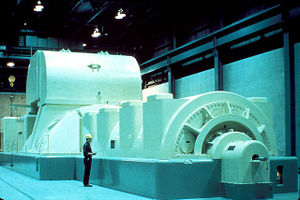Electric generator: Difference between revisions
J.williams (talk | contribs) m (1 revision imported) |
No edit summary |
||
| Line 1: | Line 1: | ||
[[Category:Done 2015- | [[Category:Done 2015-09-05]] | ||
[[File:steamturbinegen.jpg|300px|thumb|Figure 1. An electric generator and turbine.<ref>Wikimedia Commons [Online], Available: https://upload.wikimedia.org/wikipedia/commons/4/4f/Modern_Steam_Turbine_Generator.jpg</ref>]] | |||
[[File: | <onlyinclude>'''Electric generators''' are used to transform mechanical or [[Kinetic energy|kinetic energy]] into electric [[Potential energy|potential difference]], also known as [[Voltage|voltage]]. </onlyinclude> There are several power generation applications that require the use of electric generators. The first electric generators created [[direct current]] (DC), but later were replaced with the cheaper, more efficient [[alternating current]]. Almost all power plants use [[AC generation|(AC)]] generators; the exception is [[photovoltaic cell]]s. | ||
Electric generators get their kinetic energy from a [[fuel]] (like [[natural gas]]) or a [[flow]] (like [[hydro]] or [[wind]]). One particular kind of generator that runs off of [[diesel]] is the [[diesel generator]]; these are often useful in remote areas like Canada's far North, for the [[Yukon power grid]]. | |||
==References== | ==References== | ||
{{reflist}} | |||
[[Category:Uploaded]] | [[Category:Uploaded]] | ||
Revision as of 23:36, 28 August 2015

Figure 1. An electric generator and turbine.[1]
Electric generators are used to transform mechanical or kinetic energy into electric potential difference, also known as voltage. There are several power generation applications that require the use of electric generators. The first electric generators created direct current (DC), but later were replaced with the cheaper, more efficient alternating current. Almost all power plants use (AC) generators; the exception is photovoltaic cells.
Electric generators get their kinetic energy from a fuel (like natural gas) or a flow (like hydro or wind). One particular kind of generator that runs off of diesel is the diesel generator; these are often useful in remote areas like Canada's far North, for the Yukon power grid.
References
- ↑ Wikimedia Commons [Online], Available: https://upload.wikimedia.org/wikipedia/commons/4/4f/Modern_Steam_Turbine_Generator.jpg

